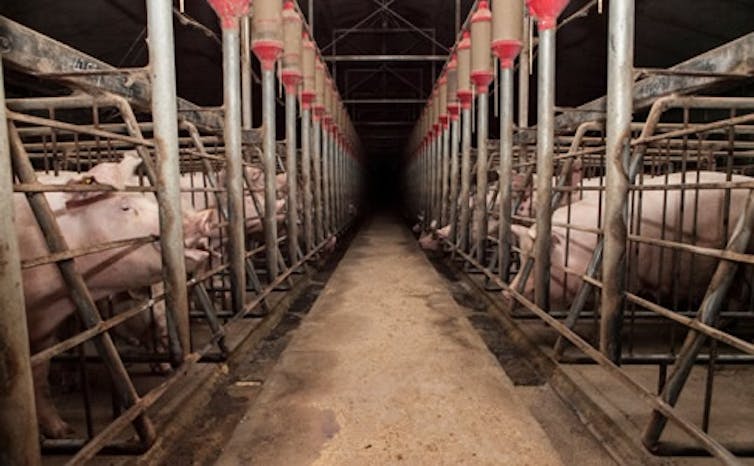
A current bill before the New South Wales Parliament proposes to end the use of sow-stalls.
Sow-stalls, sometimes referred to as gestation crates, are small metal and concrete cages measuring 2.2 by 0.6 metres in which pregnant pigs are kept for up to 105 days.
If passed, New South Wales would become the second Australian jurisdiction to do so, after the Australian Capital Territory banned their use in 2014.
But in 2010, Australian Pork Limited (APL), the peak representative body for the pork industry, agreed to a voluntary phase-out of sow-stalls by 2017.
So why do we need a ban anyway?
The problem with sow-stalls
It is hard to say for certain the extent of physical and psychological harm caused by keeping pregnant pigs in sow-stalls. Key pieces of scientific research conducted in this area have been funded either in whole or part by APL. Whether or not this funding influences the research outcomes is difficult to say.
In any event, researchers have found that the lack of exercise caused by such confinement reduces bone strength and muscle weight in sows and they report higher incidences of lameness.
We also know that these intelligent animals will bite the bars of their cage to express boredom or frustration at their confinement. The pregnant sows develop skin abrasions from the metal bars as the stall is not much larger than their body.
Furthermore, such confinement deprives these pigs from exercising natural behaviours, such as foraging for food and nesting. It is these kinds of harms that have seen sow-stalls banned or their use substantially restricted in countries such as the United Kingdom, Sweden, and New Zealand, among others.
Why is a law to ban sow-stalls necessary?
The voluntary phase-out can be seen as the industries response to market-forces. Retailers such as Coles and Woolworths have already responded to this demand.
Coles’ own brand pork products have been sow-stall free since 2013, while Woolworths is committed to sourcing all its fresh pork products from producers who use sow-stalls for less than 10% of the sows’ gestation period.
Despite the apparent success of market forces, there remain important reasons why governments still need to regulate farm animal welfare.
There are important limitations to the APL’s voluntary phase-out.
First, the phase-out only applies to APL members. Only 38% of pork producers in Australia are APL members (although they account for 94% of pig meat products), so there will still be animals not covered under the voluntary scheme.
Second, as the phase-out is voluntary, APL members who choose not to comply cannot be forced to do so – although they may be engaging in misleading and deceptive conduct if they promote their products as sow-stall free.
Third, the voluntary phase-out will be policed through industry self-regulation. This appears to involve auditing by the Australian Pork Industry Quality Assurance Program, which is owned and managed by APL.
There are limits to the efficacy of industry self-regulation given the tension that can exist between profit maximisation and animal welfare goals.
Fourth, the voluntary phase-out will not mean pigs are free-range or free from confinement. The APL voluntary phase-out provides a qualified definition of “gestation stall free”, which will allow pigs to be confined to mating stalls and farrowing crates for up to 10% of their pregnancy.
Also, the alternate to sow-stalls proposed by APL is “loose housing”, which will not guarantee any access to the outdoors, opportunities for socialising or access to bedding/nesting materials.
The need for a ban
To protect all pregnant pigs from sow-stalls, laws must be passed in each Australian State and Territory. The ACT has already done so and the current NSW bill aims to follow in its footsteps.
Although the ACT never had sow-stalls operating in its territory, the amendment to its Animal Welfare Act will ensure it stays this way.
The NSW bill is closely modelled on the ACT amendment. Both provide for “appropriate accommodation” for all pigs.
Appropriate accommodation means that pigs must be able to turn around, stand up and lie down without difficulty. The floor is to be clean, comfortable and well-drained. The facilities must enable pigs to maintain a comfortable body temperature and have access to an outdoor area.
Unlike the ACT model, the NSW bill does allow pigs to remain wholly indoors provided bedding material and enrichment objects are made available and the pig is able to move about freely.
Another difference is the requirement that pigs be housed in “compatible groups”, being “a group of two or more pigs that can be kept together without undue stress to any of those pigs.” This will help reduce aggression and fighting between pigs.
A final difference between the ACT legislation and the NSW bill is that farrowing crates (which were designed to reduce the chance of piglets being trampled or crushed by the sow) will also be banned by 2020 if the NSW bill is successful.
Although a voluntary phase-out of sow-stalls may improve the lives of some pregnant sows, a law requiring all pork producers to provide “appropriate accommodation” for the pigs in their care is the better option. This will ensure the rule covers all producers and enables direct governmental oversight.
![]() No doubt the bill will have some limitations. However, as the community’s expectations shift, the decision to end the use of sow-stalls should rest with parliament, not industry.
No doubt the bill will have some limitations. However, as the community’s expectations shift, the decision to end the use of sow-stalls should rest with parliament, not industry.
Aaron Timoshanko, Sessional Academic and Research Assistant at Flinders University, PhD Candidate, Monash University and Joanna Kyriakakis, Lecturer in Law, Monash University
This article was originally published on The Conversation. Read the original article.